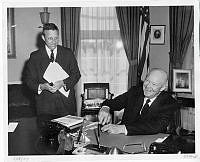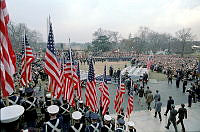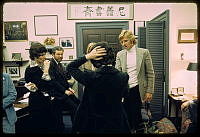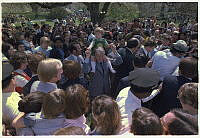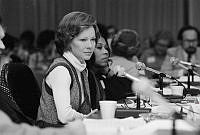Rubenstein Center Scholarship
Presidents and College Football

Gerald Ford as a center for the University of Michigan football team, 1933.
Nearly 150 years after its beginnings college football season is in full swing. The sport has attracted countless players and even more fans, and presidents have belonged to the ranks of both.
Although Theodore Roosevelt never played collegiate football because of his nearsightedness, he had more impact on the sport than any other president. In the early 1900s he joined a growing group of people who were alarmed by the viciousness of the college game. In an era without helmets or face guards, with no neutral zone between teams and no limit to how many players could be on the line at once, football could be fatal; almost 40 college and prep school players died from injuries during the 1904 and 1905 seasons.
On October 9, 1905 Roosevelt summoned representatives of Harvard, Yale, and Princeton to the White House to talk about the future of college football and he told them that unless the game was reformed it would be outlawed—perhaps by an executive order from TR himself. Partly in response, the Intercollegiate Athletic Association of the United States was formed in 1906 and it instituted rule changes, such as allowing the forward pass, which made football safer and more popular.

Dwight Eisenhower kicking a football as a member of the U.S. Military Academy team.
Dwight D. Eisenhower played football for the U.S. Military Academy at West Point, N.Y. In the days when players appeared on both sides of the ball during games, Ike was a running back on offense and a linebacker on defense. In November 1912 Eisenhower severely hurt his knee in a game against Tufts and his playing days came to an end; he was so depressed that he seriously considered quitting the Academy. He recalled years later that “Life seemed to have little meaning. A need to excel was almost gone.” Ike’s spirits soon recovered and he coached West Point’s junior varsity football team.

John F. Kennedy enjoyed playing touch football with family and friends and watching collegiate football games throughout his life. Here he tosses the coin just before the Orange Bowl contest between Alabama and Oklahoma, January 1, 1963.
After John F. Kennedy transferred from Princeton University to Harvard in 1936, he tried out for the varsity football team but was underweight at 156 pounds and ended up playing wide receiver on the junior varsity squad. Speaking in 1961 to the National Football Foundation and Hall of Fame Banquet, President Kennedy observed: “Politics is an astonishing profession—it has … enabled me to go from being an obscure member of the junior varsity at Harvard to being an honorary member of the Football Hall of Fame.”
Richard Nixon played football for Whittier College in California during 1932-1934 as a substitute tackle. Although his collegiate football career did not go entirely as he had hoped, Nixon remained a devoted fan and as president enjoyed interaction with college teams and their coaches. In 1969 he told the National Football Foundation and Hall of Fame: “I look back on football and have many pleasant memories. I just enjoyed playing it, watching it, reading about it over the years.”

Ronald Reagan on the Eureka College football team, 1929.
For many people Ronald Reagan’s connection to college football involves his portrayal of Notre Dame’s star halfback George Gipp in the 1940 film “Knute Rockne: All-American,” but Reagan was also a college football player in real life. Reagan was a starting guard for the Golden Tornadoes of Eureka College near Peoria, Illinois (he also belonged to the swimming and track-and-field relay teams). After graduation from Eureka in 1932 he worked as a part-time announcer of University of Iowa home football games for Davenport, Iowa’s radio station WOC.
Gerald R. Ford had the most distinguished college gridiron career of any president; he was a member of the University of Michigan’s 1932 and 1933 and national championship teams. The Wolverines also won Big Ten Conference titles in 1932 and 1933 with Ford on their roster. In 1935 Ford graduated from Michigan and played in the College All-Star Game against the NFL champion Chicago Bears. He received offers from both the Detroit Lions and Green Bay Packers to try his hand at the professional game, but turned them down. “Pro ball did not have the allure it has now,” he recalled 30 years later. “Though my interest was piqued at the time, I didn’t lose sleep over the offers.” Instead Ford enrolled at Yale University Law School, where graduated in 1941.

Herbert Hoover as a student at Stanford University, 1894.
Herbert Hoover didn’t play football for Stanford University, but as the football team’s business manager he played a crucial role in arranging for Stanford to play the University of California on March 19, 1892—one of the first major intercollegiate football games on the west coast. Hoover rented a baseball field in San Francisco for $250 and had 5,000 tickets printed with admission at two dollars each. The tickets were snapped up quickly, but on game day so many extra fans turned out—and paid for admission in cash—that a desperate Hoover grabbed some fellow Stanford students to search the neighborhood for pots, pans, buckets, and cloth bags that could hold the bills and coins that were part of Stanford’s share of the receipts. Eventually $20,000 was collected and Hoover, fearful of robbery, did not see the game but instead stayed in his hotel room guarding the money.














